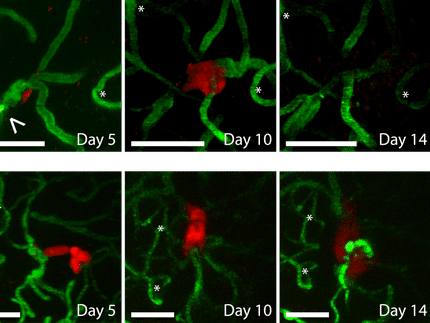New compound unleashes the immune system on metastases
A new nanocomplex renders a tumor harmless – and, on top of that, it trains the immune system to detect and eliminate metastases
An international research team headed by Dr. Johannes Karges of the Faculty of Chemistry and Biochemistry at Ruhr University Bochum, Germany, has developed nanoparticles that accumulate in cancer cells and eliminate them after being photoactivated. In addition, they label them in such a way that immune cells learn to eliminate similar cells throughout the body. This means that even undetected metastases can be treated. The researchers presented their findings in the journal Nature Communications of 2 September 2023.
The malicious nature of cancers means that they spread throughout the body: cells from the primary tumor grow into surrounding tissue and travel through the bloodstream and lymphatic system to distant organs, where they form secondary metastatic tumors. “While we now have effective methods to combat primary tumors, metastases are still very difficult to treat,” explains Johannes Karges. “Ninety percent of people who die from cancer die from metastases and tumor regression, not from the primary tumor.”
Together with an international team, he’s developed a drug packaged in nanoparticles that are administered into the bloodstream. “Tumors grow rapidly and uncontrollably, and their tissue is therefore leaky,” he describes. “Unlike in healthy tissues, the nanoparticles therefore accumulate in them easily.” This also means that the particles preferentially accumulate in tumor cells.
Step one: treating a known tumor
At the time of administration, the drug is still ineffective. It only takes effect when activated with light. If there are sufficient nanoparticles in a detected tumor, they can be activated by irradiation with light, for example during surgery. After this energy supply, the active species ensures that immunogenic cell death occurs: the tumor cells containing the photoactivated nanoparticles are eliminated, and the tumor treated by this method disappears.
Step two: sending immune cells on a search
But that’s not all: the nanoparticles and their light-induced effect cause massive oxidative stress in the endoplasmic reticulum of the cells of the treated tumor. “This alerts the body’s own immune system,” explains Johannes Karges. “The immune cells recognize that something is going completely wrong in cells of this type, and that such cells therefore need to be eliminated.” This applies not only to the cells of the photo-treated tumor itself, but to all cells of the same kind throughout the body. “Accordingly, the immune system starts looking for further metastases and renders them harmless,” says Johannes Karges.
The research team proved this active principle in experiments on cancer cells and in animal models. They applied it to effectively treat mice that had been implanted with cells from metastasized and incurable human tumors. “Now, we’re looking for industrial partners who will help us undertake more in-depth studies,” says Johannes Karges. He expects that several more years of development work will be needed before the technology can be widely used in clinical applications.
Original publication
Most read news
Other news from the department science
These products might interest you

Eclipse by Wyatt Technology
FFF-MALS system for separation and characterization of macromolecules and nanoparticles
The latest and most innovative FFF system designed for highest usability, robustness and data quality

DynaPro Plate Reader III by Wyatt Technology
Screening of biopharmaceuticals and proteins with high-throughput dynamic light scattering (DLS)
Efficiently characterize your sample quality and stability from lead discovery to quality control

Get the life science industry in your inbox
By submitting this form you agree that LUMITOS AG will send you the newsletter(s) selected above by email. Your data will not be passed on to third parties. Your data will be stored and processed in accordance with our data protection regulations. LUMITOS may contact you by email for the purpose of advertising or market and opinion surveys. You can revoke your consent at any time without giving reasons to LUMITOS AG, Ernst-Augustin-Str. 2, 12489 Berlin, Germany or by e-mail at revoke@lumitos.com with effect for the future. In addition, each email contains a link to unsubscribe from the corresponding newsletter.






















































